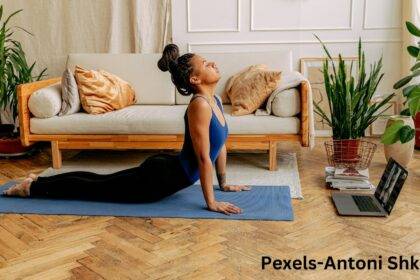This post may contain affiliate links, and Sweet Lyfe Daily may earn a small commission from purchases made through link at no additional cost to you. As an Amazon Associate Partner, Sweet Lyfe Daily may earn a commission from qualifying purchases. Please do your own research before making any purchases. Please click to read our full Disclaimer. Thank you for your support.
Dear Sweet Friends,
From my earliest memories, I have been deeply fascinated with health and wellness. The pursuit of optimal health has been a passion that has motivated me to explore methods that utilize the power of our inner capacities and reduce reliance on external factors. The belief that the pursuit of well-being should be an enjoyable and enriching experience has consistently guided my journey.
In this pursuit, I’ve uncovered an array of practices that have improved my health and infused my life with energy. In this post, I’ll share my insights into 5 powerful alternative mind-body practices that have transformed my health and well–being as a whole.
How it all Started
Meditation and Yoga was my initial introduction into mind-body practice that offered various mental and physical health benefits. I was determined to incorporate these practices into my daily routine and even though it was challenging I did my best to stick with it. I even went as far as enrolling in a mindfulness course, recognizing meditation’s immense value despite its initial challenges. However, there was a persistent hurdle I had to overcome each time – the struggle to initiate these practices and seamlessly integrate them into my daily life.
Don’t get me wrong, the post-practice sense of well-being was undeniable, but the resistance I felt towards these practices seemed to overshadow the benefits awaiting me at the finish line. During this phase of my journey, I decided to explore alternative practices. Practices that would offer similar benefits while being more accessible and enjoyable to incorporate into my holistic health routines.
Where my Curiosity Lead me?
Now, let’s delve into the five powerful alternative mind-body practices I’ve found to be immensely beneficial and explore the scientific advantages of each.
*Of note, please reach out to a medical practitioner before starting any of these practices*
1) Yoga Nidra
This is the closest to traditional meditation out of the 5 practices. Often referred to as “ yogic sleep,” it is a guided meditation technique that induces deep relaxation while maintaining awareness. This practice combines elements of mindfulness, breath awareness, and body scanning. The goal is to reach a state of consciousness that allows for profound relaxation and rejuvenation.
In my journey, Yoga Nidra has emerged as an invaluable relaxation tool that stands apart from traditional meditation practices. One of the distinctions I’ve noticed is the focus that Yoga Nidra creates within my mind. Unlike meditation, where wandering thoughts can often interrupt the process, Yoga Nidra facilitates a deep and sustained state of concentration.

Despite the relaxation achieved in Yoga Nidra, I don’t encounter the typical struggle with drowsiness that can occasionally accompany my meditation practice. I found the perfect balance, allowing me to remain fully alert while leaving me feeling rejuvenated, similar to the restorative effects of a refreshing nap.
Beyond its relaxation benefits, Yoga Nidra has played a pivotal role in elevating my self-awareness and mindfulness, enhancing my overall sense of presence and connection with the present moment. Yoga Nidra induces relaxation and is renowned for its reported benefits, including stress reduction, improved sleep, emotional healing, and heightened self awareness. Yog Nidra has become one of my favorite alternative mind- body practice.
2) Qigong: Balancing Life Energy
Another powerful alternative mind-body practice I tried is Qigong. Qigong is a holistic practice rooted in Traditional Chinese Medicine (TCM) that combines movement, breath control, and meditation to cultivate and balance the body’s vital energy, or “Qi.” It has been practiced for thousands of years and is believed to enhance physical and mental health.
My introduction to Qigong came from a friend who stumbled upon an article recounting a person’s remarkable healing journey through this ancient practice. Intrigued and keeping an open mind, I decided to embark on my exploration of Qigong. Although I’m still relatively new to this practice, I’ve begun incorporating short daily morning sessions into my routine.
Qigong has quickly become a cherished ritual, providing a serene and rejuvenating way to kickstart my day. Its ability to anchor my attention in the present moment sets Qigong apart, especially in the early hours. Instead of being preoccupied with my lengthy to-do list, I focus on the practice. It is like a mental reset button, clearing away mental clutter and allowing me to approach the day with a calm and centered mind.
It also serves as a gentle yet invigorating way to awaken my body, preparing it for the demands of the day ahead. The gradual, deliberate movement helps ease any stiffness and tension, ensuring that I start my day with a body that feels both relaxed and ready for action.
Research has shown that regular Qigong practice can lead to stress reduction, a significant boost in energy levels, alleviation of chronic pain, immune system boost, emotional balance, and improved posture. As I continue to delve deeper into Qigong, I am eagerly anticipating the myriad benefits it has in store for me. This practice has already become essential to my daily routine, offering a harmonious blend of physical and mental well-being that sets a positive tone for the rest of my day.
3) Breathwork: Harnessing the Power of Breath
Breathwork encompasses various techniques that focus on conscious control of the breath. This alternative mind- body practice promotes relaxation, manages stress, and improves overall mental and physical well-being. One of the most well-known forms of breathwork is Pranayama from yoga traditions.
My quest for an immediate energy boost when a nap or extended rest was not feasible led me to the remarkable Wim Hof breathing technique. The first time I embarked on the 11-minute journey of this practice, I was surprised by the immediate surge of energy. This newfound energy made me fully capable of tackling the remainder of my day with renewed vigor.
This powerful method has since become my go-to solution whenever I feel fatigue setting in. As I continue to incorporate it into my routine as needed, I’m eagerly looking forward to exploring the full spectrum of benefits such as stress reduction, improved focus, enhanced athletic performance, improved lung function and better sleep that Wim Hof breathing has to offer.

It’s important to note that while Wim Hof breathing boasts many advantages, specific contraindications should be known. Individuals with pre-existing breathing issues or severe heart conditions, including cardiac arrhythmia, slow heart rate, high blood pressure, angina or chest pain, a recent heart attack, heart disease, or any other heart-related condition, should exercise caution. Before embarking on this breathwork journey, I strongly advise consulting with a healthcare professional to ensure it aligns with your health needs and circumstances. Safety and well-being should always be prioritized when exploring new practices like Wim Hof breathing.
4) Body Tapping: Energetic Release
Body tapping, also known as Emotional Freedom Techniques (EFT) or tapping therapy, involves lightly tapping specific acupressure points on the body while focusing on emotional issues or physical discomfort. This alternative mind- body practice aims to release blocked energy and promote emotional healing.
Body tapping was an unexpected addition to my holistic practices, born out of momentary necessity. While I had heard of tapping before, I had never ventured into it until one day when I found myself teetering on the edge of anxiety and frustration just before a crucial meeting. In need of a quick solution, I decided to give it a shot and complete a 10-minute tapping routine.
Surprisingly, my anxiety and frustration began to recede significantly during the practice. By the time the meeting rolled around, I was composed and able to navigate it with surprising ease and success. Due to the unplanned encounter with body tapping, it has become a tool I can readily turn to during challenging moments.
Out of the five practices in my holistic toolkit, I admit that I engage in body tapping less frequently than the others. However, its unique ability to quickly alleviate emotional unrest and restore equilibrium makes it an invaluable resource in my wellness tool box. The benefits attributed to body tapping, including emotional healing, pain management, stress reduction, improved self-acceptance, and enhanced energy flow, make it a practice worth exploring further.

5) Functional Movement: Mindful Body Exercise
Functional movement is a practice that emphasizes natural and functional movements, such as squatting, lifting, and carrying, to improve physical fitness and mobility. While not a traditional meditation practice, it promotes mindfulness of the body and breath during movement.
Functional movement has been an alternative mind-body practice I’ve embraced on and off for many years, often as a “fallback” after attempting to commit to yoga. While I recognize yoga’s many benefits and continue to practice it when the mood strikes, my previous commitment to it may have been influenced by its popularity rather than a genuine personal preference.
Reflecting on my relationship with these practices, I discovered I genuinely enjoyed functional movement more. I realized that functional movement provides a holistic approach to fitness, offering a comprehensive blend of strength, mobility, and flexibility benefits. What sets it apart is its ability to deliver an effective workout without leaving you drained or excessively sore the following day. Functional movement has proven great when I don’t quite feel up to an intense workout but still want to get my body moving. Moreover, it makes everyday activities like bending and squatting feel effortless.
Beyond physical fitness, functional movement promotes mindfulness and body awareness, aids injury prevention, reduces stress, and significantly improves posture. Functional movement has become an integral part of my fitness routine, offering a versatile and accessible path to maintaining a healthy and balanced lifestyle.
Last Sweet Words
Incorporating alternative practices like Yoga Nidra, Qigong, Breathwork, Body Tapping, and Functional Movement into your daily routine can offer a refreshing change from traditional and more popular holistic practices and provide a wealth of mental and physical benefits.
Give yourself permission to get or remain curious, experiment with these alternatives to find the one that resonates most with you and suits your needs. Whether you seek relaxation, emotional healing, increased vitality, or improved physical fitness, these practices can serve as valuable tools on your journey to holistic well-being. Also exploring these different practices serves as a compelling reminder that sometimes, the most transformative discoveries happen by chance, offering us powerful tools to navigate the complexities of life with grace and resilience.
Stay Curious!
Sweet Lyfe Daily
Let us know in the comments if you have tried any of these alternative mind- body practices





